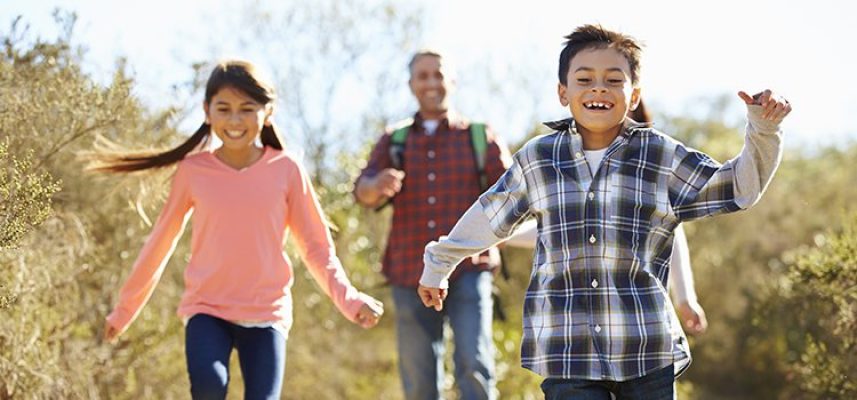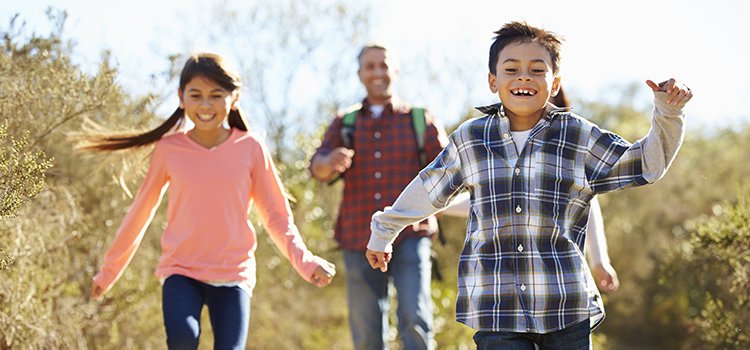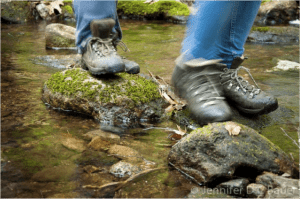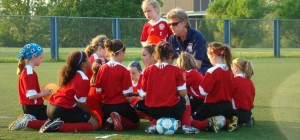Get the family outside for some fun and fresh air with these hiking tips from an ActivityHero expert.
By Laura Quaglio
Getting out for a hike is a great way to spend a weekend or evening with your family. According to the National Wildlife Federation, the average American kid spends as little as half an hour in outdoor “free play” each day … and more than seven hours staring at a computer screen. That’s a shame, since playing outside has been linked to a wide array of health and wellness perks for kids, including some surprises such as better in distance vision, improved test performance at school, and healthier social interactions.
See a List of Outdoor Camps Near You >>
ActivityHero provider Kurt Gantert, Founder and Director of Wanderers*, is thrilled that science has proven some of the things that “outdoorsy people” have long known. “My parents took me hiking at an early age, so I grew up just kind of loving it,” says Kurt, who has fond memories of exploring the Adirondacks with his folks, siblings, and friends. Drawing on those early outdoor experiences, Kurt has built a career in the field of outdoor education/adventure travel, working as a wilderness guide and educator for more than 20 years. Today, he likes nothing better than leading kids in Northern California (including his own two children) on outdoor explorations throughout the year. “What I notice is that kids have a sense of freedom outdoors that they don’t often have in our very scheduled world,” adds Kurt. “Nature has a very calming effect.”
Of course, nature also offers plenty of challenges that indoor and at-home activities do not. That’s why Kurt favors being well-prepared before setting out with your brood. (Plus, if kids wind up hungry, hurt, or over-tired, they won’t want to hit the trail ever again.) To help ensure a positive adventure, Kurt offers these tips to consider before hitting the trail.
1. Let Kids Bring a Buddy
“Always try to invite another family along on your hike,” suggests Kurt. Taking some of your kids’ friends on your excursion can prevent them from complaining throughout the trip. When children are around their peers, explains Kurt, they’re distracted and less likely to be bored — and they won’t want to “look bad” in front of their friends, so they’re more likely to grin and bear it when the going gets a little tough.
2. Check the Conditions
Look up what the weather will be in the area you’re planning to hike. It may be very different from the weather at your house, even if you’ll be fairly close by. You can check the websites for The Weather Channel or NOAA (National Oceanic and Atmospheric Administration) to find out what’s brewing.
Kurt also suggests researching the terrain. Are there any big hills? Is it likely to be muddy? Kids will enjoy themselves more if there aren’t too many obstacles to overcome. If you’re not sure where to go, check American Trails to search more than 1,100 recreation trails in the U.S., or use the Web to search for family-friendly trails in your area. You may also prefer to stick to trails that offer bathroom facilities, guides, and other amenities, especially if you’re not an avid outdoors person or you have little ones in tow. “Sometimes national parks have guide posts and offer special ranger talks,” says Kurt. “These are often volunteers who are trained in certain subjects. For instance, guides at Point Reyes National Seashore just north of San Francisco share interesting information about Tule elk during the rut season. Listening to ranger talks can make the experience more fun for the group,” says Kurt.
See National Park Activities Near You >>
3. Don’t Pack Light
When Kurt hikes in national or state parks throughout the country, he often notices how under-prepared people are for hiking. “You should bring a backpack filled with a lot of stuff,” says Kurt. “Don’t feel it’s a burden, as some of the items you bring could be crucial to a more enjoyable hike.” Some of his suggestions include healthy snacks, sunscreen, bug spray, binoculars, a camera, and a simple first-aid kit. “Kids fall down and skin their elbows all the time,” says Kurt. If your children have allergies, also bring their EpiPen and some Benadryl. And, of course, carry plenty of water. “Pack more water than you think you’ll need,” he says. “At least two pretty-good-sized bottles per person for a full-day hike.” For little kids — or if you’ll be near a lake, stream, or pond — bring towels and a change of clothes, too, including fresh socks.
4. Get a Few Guidebooks
Kurt loves to tote a few such books along on his hikes so kids can look up birds, animals, and plants they see along the way. If you’re taking tweens or teens on the hike, consider downloading an app that allows kids to take a photo of a plant or animal and automatically IDs what they see. Kids in these age groups can also serve as the family videographer/photographer, documenting special moments on the trail.
One caveat: Turn off the tech if it starts detracting from the experience instead of enhancing it. Kurt’s camps don’t allow any use of technology by kids because they often will go from taking a photo to checking Instagram. For that reason, Kurt sticks to paper guidebooks for use in Wanderers programs. Two of his favorites: The Sibley Guide to Birds and the National Audubon Society Field Guide to California.
5. Plan Some Play Time
Choose a destination that the kids will really enjoy — such as a beach or a stream where they can splash around. In fact, if your kids are young, Kurt suggests keeping the actual hiking portion of the adventure fairly short, ending up at a kid-friendly spot and spending as long as they like in “free-play” mode. As kids get older (and their legs and attention spans lengthen), you can increase the distance of your family hikes.
Kids seem to instinctively love playing in nature, but if yours aren’t sure what to do, get into the act with them and build with rocks or sticks, skip stones across a pond, search for animal habitats, do rubbings of tree bark with a crayon and paper, and even sketch what you see in a notebook. “Free play is very important for kids, and there’s less and less of it in this day and age,” says Kurt.
6. Dress for Success
Even in the warmer months in California, Kurt doesn’t generally hike in shorts because of ticks and poison oak. He prefers comfortable hiking pants, some “sturdy hiking socks” (not low athletic-style socks), and several layers on top so he can make adjustments when the temperature changes. Regardless of the forecast, Kurt recommends including options that will be appropriate for all types of weather. “In the mountainous regions of the West Coast, you can get snow even in the summertime,” he says. “Always bring an extra warm layer.” He also advises heading out early so you won’t be at a higher elevation later in the day. “In mountain ranges, such as the Sierra Nevada in California, thunderstorms can roll in during the afternoon,” he says. You don’t want to get caught out in one of those.
As for footwear, don’t wear brand-new hiking shoes or boots on a long hike. “That’s a good recipe for a blister,” says Kurt. Break in new hiking boots gradually over time before taking them on a long trek. Usually, he notes, sneakers are fine for a day hike on a well-maintained and not-too-rocky trail.
Kurt holds such a session at the end of each week of camp at Wanderers. “We get the kids to talk about what was special to them and what they learned,” he says. “It’s interesting. What they say is not always what you’d think of.” The trick here? Don’t just ask, “What was your favorite thing?” Most of the time, after one kid speaks up, everyone agrees that they loved that part of the day, too. Instead, mentally walk your whole family through the journey again. Mention each stop you made or each plant or animal you identified. Ask what each person saw and what surprised them. Share what surprised you, too. You might even want to video what your kids say — and make some notes about whatever you learned from the trip. What items did you wish you’d brought? Which ones should have been left at home? What would you never do again? What would you like to do more of? Keep this list with your hiking gear, so you can reference it before your next family excursion.
Consider Enrolling Kids in an Outdoor Adventure Camp
While hiking as a family offers certain perks, exploring the outdoors with trained professionals provides kids with another level of experience that can be valuable for any child, says Kurt. For one thing, Kurt’s programs focus on “experiential education.” “We’re not just sitting in a classroom learning about where our tap water comes from,” says Kurt. “We hike to the reservoirs and/or watersheds that provide our water, and we have discussions about what they are and the natural and human history behind each one.” Each day begins with an instructor giving a short talk to prep kids for the day, and then they head out and put those concepts and vocab words to use. Each trek is mapped out carefully, with rest stops along the trail where instructors stop to point out special features while giving kids a water break and rest.
If you’d like to find a great outdoor adventure camp in your area, Kurt suggests you ask a few questions about the staff and their safety practices. Find out:
- Who is the director and how involved are they in the day-to-day operations?
- How long has the camp been around?
- What is the camp’s safety record?
- What is the staff-to-camper ratio? (Wanderers usually offer a 1:5 ratio, but 1:7 is also very good for hiking or camping, particularly with older kids.)
- What training does the staff have? (Wanderers staffers are at least 21 years old and have a minimum of 2 years’ experience leading outdoor activities. They are also certified in wilderness first aid and CPR, and many have their Wilderness First Responder certification. Wanderers also provides staff with a week-long training session and other training as needed.)



















